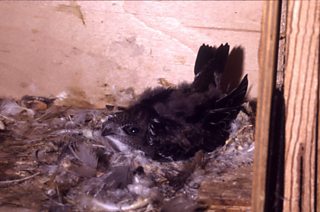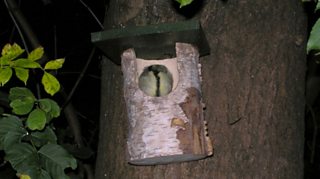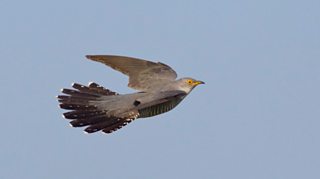Hibernation is something that birds just don’t do, not in the true sense of the word, but there are a few species that come pretty close, such as the Common Poorwill (North American Nightjar), which can spend weeks in a state of torpor during the winter months.

Swift Chick by Graham Roberts
In the UK there’s one bird that occasionally goes into a sort of mini-hibernation during cold snaps in their breeding season. arrive back in the UK around the end of April and immediately get on with the business of producing a brood of youngsters. Swifts are supreme aerial feeders; when they have youngsters to feed they are on the wing all day, trawling for insects with their gaping mouths and turning them into a ball of protein to feed to their chicks. During very cold or wet weather these small insects are not so readily available and the adult birds have to forage farther away from the nest, sometimes hundreds of miles away. Most young birds, such as tits or thrushes, would die without regular feeds but young Swifts can enter a state of torpor, reducing their metabolic rate in the hope that the weather will improve and food will be provided.

Roosting Great Tit by Leo du Feu
Even common birds, such as and can change the way their bodies operate, so as to see them through tricky winter conditions. On a nest camera, you can see just how spherical the body becomes, as feathers are fluffed up and the surface-area to volume ratio is reduced, and how the bill and head are tucked away, these being the parts of the body which lose most heat. What you cannot see is that the bird also drops its temperature by as much as ten degrees, to further minimise heat loss. This is called nocturnal hypothermia; by reducing the difference between body temperature and outside temperature, the flow of heat from the body drops. None of our wintering birds use torpor, which would also involve reducing the metabolic rate.

Cuckoo by Steve Ashton
The main strategy for coping with the extremes of cold weather is to move, and many of our birds do just that – not that it is an easy option though. Some of the birds that visit us for the summer months travel huge distances to suitable overwintering areas, journeys that can be incredibly hazardous. The BTO satellite tagged brought this home in 2012 as the five birds tagged in 2011 struggled to get back to the UK to breed, and birds that were tagged in the summer of 2012 struggled to make it to Africa. Fortunately, five of the birds did manage to find enough food at their stopover sites and avoid the summer storms, making it back to the mighty Congo Rainforest, Including Chris, the �������� Springwatch cuckoo.
You can follow these birds at http://www.bto.org/science/migration/tracking-studies/cuckoo-tracking